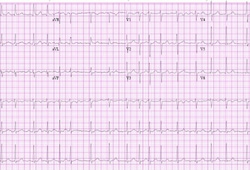Resumen
Definición
Anamnesis y examen
Principales factores de diagnóstico
- irregular pulse rate
Otros factores de diagnóstico
- palpitations
- hypotension
- elevated jugular venous pressure
- added heart sounds
- dizziness
- dyspnea
- rales
- evidence of stroke
Factores de riesgo
- increasing age
- hypertension
- orthostatic hypotension
- diabetes mellitus
- heart failure
- valvular and structural heart disease
- coronary artery disease and acute coronary syndromes
- other atrial arrhythmias
- sepsis and critical illness
- cardiac or thoracic surgery
- obesity
- hyperthyroidism
- hypoxic pulmonary conditions
- alcohol consumption
- smoking
- inflammatory disorders
- excessive exercise
- height
- cancer and chemotherapy
Pruebas diagnósticas
Primeras pruebas diagnósticas para solicitar
- ECG
- serum electrolytes
- cardiac biomarkers
- thyroid function tests
- CXR
- transthoracic echocardiogram
- transesophageal echocardiogram (TEE)
Tests to avoid
- coronary CT angiography
Pruebas diagnósticas que deben considerarse
- electrophysiologic study
- exercise stress tests
Algoritmo de tratamiento
hemodynamically unstable
hemodynamically stable with left atrial thrombus, or presence of thrombus unknown/duration of AF unknown
hemodynamically stable without left atrial thrombus: symptom onset <48 hours
hemodynamically stable without left atrial thrombus: symptom onset ≥48 hours
hemodynamically stable without left atrial thrombus: asymptomatic
Colaboradores
Autores
Arti N. Shah, MS, MD
Director
Cardiac Electrophysiology
Elmhurst Hospital Center
Elmhurst
Assistant Professor of Medicine
Mount Sinai School of Medicine
New York
NY
Divulgaciones
ANS declares that she has no competing interests.
Bharat K. Kantharia, MD, FRCP, FAHA, FACC, FESC, FHRS
Clinical Professor of Medicine
Icahn School of Medicine at Mount Sinai
President
Cardiovascular and Heart Rhythm Consultants
Attending and Consultant Cardiac Electrophysiologist
Mount Sinai Hospitals
New York Methodist Hospital
New York
NY
Divulgaciones
BKK declares that he has no competing interests.
Revisores por pares
Diwakar Jain, MD, FACC, FRCP, FASNC
Professor of Medicine (Cardiology)
Westchester Medical Center
Valhalla
NY
Divulgaciones
DJ declares that he has no competing interests.
Farooq A. Padder, MD, MRCP, FACC
Assistant Professor of Medicine
Hahnemann University Hospital
Woodbury
NJ
Divulgaciones
FAP declares that he has no competing interests.
Kim Rajappan, MA, MD, MRCP
Consultant Cardiologist and Electrophysiologist
Cardiac Department
John Radcliffe Hospital
Oxford
UK
Divulgaciones
KR declares that she has no competing interests.
Agradecimiento de los revisores por pares
Los temas de BMJ Best Practice se actualizan de forma continua de acuerdo con los desarrollos en la evidencia y en las guías. Los revisores por pares listados aquí han revisado el contenido al menos una vez durante la historia del tema.
Divulgaciones
Las afiliaciones y divulgaciones de los revisores por pares se refieren al momento de la revisión.
Referencias
Artículos principales
Joglar JA, Chung MK, Armbruster AL, et al. 2023 ACC/AHA/ACCP/HRS guideline for the diagnosis and management of atrial fibrillation: a report of the American College of Cardiology/American Heart Association Joint Committee on clinical practice guidelines. Circulation. 2024 Jan 2;149(1):e1-156.Texto completo Resumen
Hindricks G, Potpara T, Dagres N, et al. 2020 ESC Guidelines for the diagnosis and management of atrial fibrillation developed in collaboration with the European Association for Cardio-Thoracic Surgery (EACTS). Eur Heart J. 2021 Feb 1;42(5):373-498.Texto completo
Artículos de referencia
Una lista completa de las fuentes a las que se hace referencia en este tema está disponible para los usuarios con acceso a todo BMJ Best Practice.

Diferenciales
- Atrial flutter
- Wolff-Parkinson-White syndrome
- Atrial tachycardia
Más DiferencialesGuías de práctica clínica
- 2023 ACC/AHA/ACCP/HRS guideline for the diagnosis and management of atrial fibrillation: a report of the American College of Cardiology/American Heart Association Joint Committee on clinical practice guidelines
- 2023 ACC/AHA/ACCP/HRS guideline for the diagnosis and management of atrial fibrillation: a report of the American College of Cardiology/American Heart Association Joint Committee on clinical practice guidelines
Más Guías de práctica clínicaFolletos para el paciente
Atrial fibrillation: what is it?
Atrial fibrillation: what are the treatment options?
Más Folletos para el pacienteCalculadoras
GARFIELD-AF
Atrial Fibrillation CHA(2)DS(2)-VASc Score for Stroke Risk
Más CalculadorasVideos
How to perform an ECG: animated demonstration
Más vídeosInicie sesión o suscríbase para acceder a todo el BMJ Best Practice
El uso de este contenido está sujeto a nuestra cláusula de exención de responsabilidad